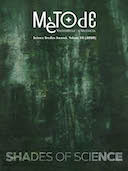Einstein y la física nazi: Cuando la ciencia se enfrenta a la ideología y a los prejuicios
DOI:
https://doi.org/10.7203/metode.10.13472Palabras clave:
Albert Einstein, nazismo, antisemitismo, ciencia e ideología Resumen
Resumen
En las décadas de 1920 y 1930, en una Alemania tomada por un antisemitismo creciente y generalizado, y más tarde con el ascenso del nazismo, la física de Albert Einstein fue recibida con hostilidad y fue atacada por motivos raciales. El asalto fue orquestado por dos premios Nobel de Física que defendían que los rasgos raciales estereotípicos afectaban al pensamiento científico. Sus acciones muestran cómo la ideología puede infectar y modular la actividad científica. Desde el prisma actual, este episodio sigue siendo una historia con una moraleja muy instructiva.
 Descargas
Descargas
 Citas
Citas
Cassidy, D. C. (2009). Beyond uncertainty: Heisenberg, quantum physics, and the bomb. New York: Bellevue Literary Press.
Clark, R. W. (1973). Einstein: The life and times. London: Hodder & Stoughton.
Einstein, A. (1949). The world as I see it.New York: Philosophical Library.
Einstein, A. (1954). Ideas and opinions. New York: Bonanza Books.
Folsing, A. (1998). Albert Einstein: A biography. Harmondsworth: Penguin.
Heilbron, J. L. (2000). The dilemmas of an upright man: Max Planck and the fortunes of German science. 2nd ed. Cambridge: Harvard University Press.
Hentschel, K. (Ed.). (1996). Physics and National Socialism: An anthology of primary sources. A. M. Hentschel (Transl.). Basel: Birkhauser Verlag.
Kershaw, I. (2008). Hitler, the Germans, and the final solution. New Haven: Yale University Press.
Kurlander, E. (2009). Living with Hitler.New Haven: Yale University Press.
Mosse, G. L. (Ed.). (1966). Nazi culture: Intellectual, cultural and social life in the Third Reich, p. 206. New York: Grosset & Dunlap.
Nathan, O., & Norden, H. (Eds.). (1963). Einstein on peace. New York: Simon & Schuster.
Rosbaud, P. (1945). Rosbaud correspondence and manuscripts 1945. (Series IV, Box 28, Folder 42). Samuel Goudsmit Papers. American Institute of Physics.
Szilard, L. (1979, March). Excerpts. Leo Szilard: His versions of the facts II. Bulletin of the Atomic Scientists, 35(3), p. 55–59.
Van Dongen, J. (2007). Reactionaries and Einstein’s fame: “German Scientists for the Preservation of Pure Science”, relativity, and the Bad Nauheim Meeting. Physics in Perspective, 9(2), 212–230. doi: 10.1007/s00016-006-0318-y
Walker, M. (1995). Nazi science: Myth, truth and the German atomic bomb. New York: Plenum.
Descargas
Publicado
Cómo citar
-
Resumen3507
-
PDF 1201
Número
Sección
Licencia
![]()
Todos los documentos incluidos en OJS son de acceso libre y propiedad de sus autores.
Los autores que publican en esta revista están de acuerdo con los siguientes términos:
- Los autores conservan los derechos de autor y garantizan a Metode Science Studies Journal el derecho a la primera publicación del trabajo, licenciado bajo una licencia de Creative Commons Reconocimiento-NoComercial-SinObraDerivada 4.0 Internacional, que permite a otros compartir el trabajo con un reconocimiento de la autoría del trabajo y citando la publicación inicial en esta revista.
- Se permite y se anima a los autores a difundir sus trabajos electrónicamente a través de páginas personales e institucionales (repositorios institucionales, páginas web personales o perfiles a redes profesionales o académicas) una vez publicado el trabajo.





